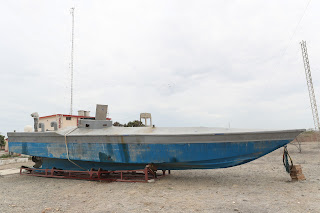Friday Hodgepodge
Friday, January 13, 2023
Four Submerged Things
1. I pass through Mobile, Alabama, a few times a year, and my route takes me past the USS Alabama, a hulking battleship moored in a memorial park and quite visible from the Interstate. Little did I know that another piece of naval history -- also visible from a highway -- lies nearby, in Bayou La Batre.
The shrimping village, which inspired the fictional town of Greenbow in Forrest Gump, is host to a Soviet-era mini-sub, of all things:
Built in Leningrad between 1968 and 1972 for the Soviet Ministry of Fisheries to research fish concentrations, Project 1825 produced two "North" (Sever) type submersible, dubbed "Север-2" (Sever-2) and Sever-2 Bis.In the 1990's, an entrepreneur purchased the submarine and moved it to a local shipyard. It has remained there ever since.
Complete with manipulator arms, seven viewing ports (3x 140mm, 4x60mm) and the ability to dive to as deep as 2,000m, they were legit minisubs for their day, akin to the U.S. Navy's similar Alvin DSV project which predated the Severs by a half-decade.
Operating from the 2,700-ton Soviet research ships Odissey and Ikhtiander, the two subs spent time in the Med, Atlantic, Baltic, and Pacific throughout the 1970s and 80s, conducting fisheries and oceanographic research. Electrically powered, they could motor at 3.5-knots for up to 9 hours before their batteries were drained, or simply submerge for as many as 72, carrying 3-5 operators/observers.
Their work was important enough that the Soviets showed them off in a series of postage stamps. [links in original]
2. One of the more ... interesting ... consequences of our insane "War on Drugs" is the lengths to which smugglers will go to move their artificially pricey cargo, including with so-called narco submarines, a phenomenon you may have heard of -- and which you may be surprised to learn can fill a book:
Follow the above link for a great teaser, complete with photos, and to purchase the book.10 years of research, analyzing over 160 incidents, condensed into a handy guide. This unique book systematically breaks down the types and families. With detailed taxonomy, recognition 3-views, profiles and photos.
Image by the Peruvian Ministry of Defense, via Wikimedia Commons, license.
3. A career sonarman has written a detailed and entertaining guide to the social hierarchy aboard American nuclear submarines:
Living in a machine with over 100 sailors requires a person to be flexible socially and sometimes physically. I spent two decades on United States Navy submarines performing sonar duties among eccentric personalities in incredibly stressful situations. When sailors report to their first submarine, they are joining a work culture unlike any other. Surrounded by crew members busily moving about tight spaces and narrow walkways, announcements over the circuit boxes, roving watchstanders, equipment humming to 400hz fans, it can be anxiety-inducing to any sailor.The piece brings back memories, and not just for its accuracy. I recognized someone in the photos, which is not surprising given that it's a relatively small community.
4. Paul Graham's essay, "The Submarine" will be good for a change of pace. Within, he details the larger-than-you-might-guess role of public relations firms in the news media:
PR is not dishonest. Not quite. In fact, the reason the best PR firms are so effective is precisely that they aren't dishonest. They give reporters genuinely valuable information. A good PR firm won't bug reporters just because the client tells them to; they've worked hard to build their credibility with reporters, and they don't want to destroy it by feeding them mere propaganda.This is interesting to contemplate in light of Graham's earlier claim:
If anyone is dishonest, it's the reporters. The main reason PR firms exist is that reporters are lazy. Or, to put it more nicely, overworked. Really they ought to be out there digging up stories for themselves. But it's so tempting to sit in their offices and let PR firms bring the stories to them. After all, they know good PR firms won't lie to them. [bold added]
Of the stories you read in traditional media that aren't about politics, crimes, or disasters, more than half probably come from PR firms.Graham doesn't exactly lionize the PR industry, but isn't it interesting that what is arguably the most generally accurate reporting comes from companies trying to advertise?
-- CAV


No comments:
Post a Comment